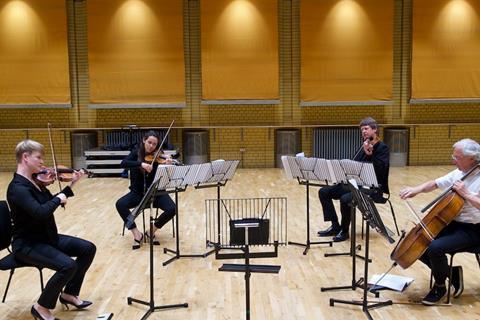Birmingham Contemporary Music Group violinist Kate Suthers shares her experience of recording Huang Ruo’s new piece during the pandemic

Playing contemporary music is often synonymous with using your instrument to make a noise you previously hadn’t thought possible, probable, or sometimes even desirable. Playing contemporary music is also synonymous with breathing life into art, sometimes for the first time, often with direct access to the artist themselves. Arguably we should approach all musical performances as if for the first time, but it’s definitely easier to do that with a score fresh from the publisher and a Zoom link to the composer, than with a dog-eared part and the years of scholarship and opinion that surround older works.
So it was that in August of this very strange year, I received an email from Birmingham Contemporary Music Group, offering me a three day patch of work to rehearse and record Huang Ruo’s piece for strings, ‘A Dust in Time’. BCMG is a group I’ve always enjoyed working with and I looked forward to collaborating once again with colleagues who I hadn’t seen for many months. The offer of work also came after the period of national lockdown where I should’ve been working upwards of seventy days, but instead had only worked for three, so it was an easy decision in every regard.
‘A Dust in Time’ is a meditation on the global pandemic. Using the symbolism of a mandala and the structure of a passacaglia, it creates an extended musical palindrome. It lasts an hour, and can be repeated to create an endless soundtrack for the contemplation of our place in the universe. The title appeals to me on macro- and microcosmic levels; that in the grand scheme of the history of the universe, 2020 is barely noteworthy, gives a hopeful perspective that this too shall surely pass. I also like that the title brings to my mind the image of a single dust mote; a tiny particle, suspended in sunlight, encapsulating the feeling of stasis - mental, physical, professional, social - that I felt during lockdown.
Read: How to record chamber music in lockdown
Read: What does it feel like to give an online chamber concert?
It was a good sign that the part was already attached to the first email. It meant the piece was finished and I could get a clear idea of what I was going to play rather than jumping blindly, albeit delightedly, into the unknown. The part looked suspiciously tonal and lyrical compared to a lot of contemporary music I’ve played. There was no appendix to decode, there were no notated extended techniques. Instead, there were thirteen pages of music that looked deceptively simple. However, when it came to the first rehearsal (at BCMG’s home venue, the CBSO Centre), my initial reading of the score was swiftly recalculated.
The score’s simplicity was in fact what posed the most difficulty. In the outer sections, the musical stasis creates a dilemma; how to maintain serenity whilst simultaneously maintaining our group pulse? It can be hard to feel the same pulse in passages of slow-moving music. Add to that an extremely quiet dynamic, two metre social distancing and little to no work for the previous three or four months to keep us all match fit, and it can be really hard to feel the same pulse. As the piece grows in complexity and intensity, the distancing element created more problems as it became difficult to hear each other whilst playing at louder dynamics. We toyed with metronomes and click tracks which solved our pulse issue, but added a rigour that felt wrong in the organic development of the music. Without click track, we all had to be more physically demonstrative, which disturbed the calmer outer sections. A conundrum, to be sure.
As always, discussion, time and focussed rehearsing solved various problems. Outside ears were more vital than ever in helping us balance our sounds. We were also lucky to have the composer himself on hand, from New York via Zoom, to offer his comments. Then, there was stamina to consider. My impression of the score belied how tiring it is to continuously carry an hour long musical arc with only four players. There are no rests in the viola part! As any brass player will tell you, the only ways to manage stamina issues are careful scheduling and resistance training. I would add that a good sports massage goes a long way.
Watch: Ebene Quartet talks about life in lockdown and performing Beethoven
Read: Running an educational chamber music programme remotely
Recording the piece was a two-stage process. Initially we had a click track set up to act as a hypnotic in-ear reminder of the pulse. We then recorded the piece again without click track, but with the aural imprint of it fresh in our reading. It’ll be different again preparing this piece for a concert performance. I think we’ll automatically take more musical risks, but most importantly we’ll have an organic way to gauge the arc of our performance , rather than trying to please a microphone.
I’ll be very curious to see how an audience will respond to the piece. Concerts have become more emotional experiences after so much time away from them. I for one am very much looking forward to the return of regular music-making. For now, we have ‘A Dust in Time’ - a piece for contemplation that is also a showcase in just how important such things are.
Birmingham Contemporary Music Group will perform ‘A Dust in Time’ live at the CBSO Centre on 13 December. A digital release will be available at https://www.bcmg.org.uk/Listing/Category/a-dust-in-time











































No comments yet